The Influence of Embedded Plasmonic Nanostructures on the Optical Absorption of Perovskite Solar Cells
Abstract
:1. Introduction
2. Materials and Methods
3. Results
4. Conclusions
Author Contributions
Funding
Acknowledgments
Conflicts of Interest
References
- Zhao, D.; Yu, Y.; Wang, C.; Liao, W.; Shrestha, N.; Grice, C.; Cimaroli, A.J.; Guan, L.; Ellingson, R.J.; Zhu, K.; et al. Low-bandgap mixed tin–lead iodide perovskite absorbers with long carrier lifetimes for all-perovskite tandem solar cells. Nat. Energy 2017, 2, 17018. [Google Scholar] [CrossRef]
- Yue, L.; Yan, B.; Attridge, M.; Wang, Z. Light absorption in perovskite solar cell: Fundamentals and plasmonic enhancement of infrared band absorption. Solar Energy 2016, 124, 143–152. [Google Scholar] [CrossRef]
- Kinoshita, T.; Nonomura, K.; Jeon, N.J.; Giordano, F.; Abate, A.; Uchida, S.; Kubo, T.; Seok, S.I.; Nazeeruddin, M.K.; Hagfeldt, A.; et al. Spectral splitting photovoltaics using perovskite and wideband dye-sensitized solar cells. Nat. Commun. 2015, 6, 8834. [Google Scholar] [CrossRef] [PubMed]
- Zhang, W.; Saliba, M.; Stranks, S.D.; Sun, Y.; Shi, X.; Wiesner, U.; Snaith, H.J. Enhancement of perovskite-based solar cells employing core–shell metal nanoparticles. Nano Lett. 2013, 13, 4505–4510. [Google Scholar] [CrossRef]
- Saliba, M.; Zhang, W.; Burlakov, V.M.; Stranks, S.D.; Sun, Y.; Ball, J.M.; Johnston, M.B.; Goriely, A.; Wiesner, U.; Snaith, H.J. Plasmonic-Induced Photon Recycling in Metal Halide Perovskite Solar Cells. Adv. Funct. Mater. 2015, 25, 5038–5046. [Google Scholar] [CrossRef]
- Carretero-Palacios, S.; Jiménez-Solano, A.; Míguez, H. Plasmonic nanoparticles as light-harvesting enhancers in perovskite solar cells: A user’s guide. ACS Energy Lett. 2016, 1, 323–331. [Google Scholar] [CrossRef] [PubMed]
- Dabirian, A.; Byranvand, M.M.; Naqavi, A.; Kharat, A.N.; Taghavinia, N. Self-assembled monolayer of wavelength-scale core–shell particles for low-loss plasmonic and broadband light trapping in solar cells. ACS Appl. Mater. Interfaces 2016, 8, 247–255. [Google Scholar] [CrossRef] [PubMed]
- Luo, A.Z.Q.; Shi, J.; Yue, L.; Wang, Z.; Chen, X.; Huang, S. Efficient perovskite solar cells by combination use of Au nanoparticles and insulating metal oxide. Nanoscale 2017, 9, 2852–2864. [Google Scholar]
- Pathak, N.K.; Chander, N.; Komarala, V.K.; Sharma, R. Plasmonic perovskite solar cells utilizing Au@SiO2 core-shell nanoparticles. Plasmonics 2017, 12, 237–244. [Google Scholar] [CrossRef]
- Cui, J.; Chen, C.; Han, J.; Cao, K.; Zhang, W.; Shen, Y.; Wang, M. Surface plasmon resonance effect in inverted perovskite solar cells. Adv. Sci. 2016, 3, 1–8. [Google Scholar] [CrossRef]
- Aeineh, N.; Barea, E.M.; Behjat, A.; Sharifi, N.; Mora-Sero, I. Inorganic Surface Engineering to Enhance Perovskite Solar Cell Efficiency. ACS Appl. Mater. Interfaces 2017, 9, 13181–13187. [Google Scholar] [CrossRef]
- Zhu, H.L.; Choy, W.C.H. Crystallization, properties, and challenges of low-bandgap Sn–Pb binary perovskites. Solar RRL 2018, 2, 1800146. [Google Scholar] [CrossRef]
- Shalan, A.E.; Oshikiri, T.; Sawayanagi, H.; Nakamura, K.; Ueno, K.; Sun, Q.; Wu, H.P.; Diau, E.W.G.; Misawa, H. Versatile plasmonic-effects at the interface of inverted perovskite solar cells. Nanoscale 2017, 9, 1229–1236. [Google Scholar] [CrossRef]
- Kim, G.M.; Tatsuma, T. Photocurrent enhancement of perovskite solar cells at the absorption edge by electrode-coupled plasmons of silver nanocubes. J. Phys. Chem. C 2017, 121, 11693–11699. [Google Scholar] [CrossRef]
- Fan, R.; Wang, L.; Chen, Y.; Zheng, G.; Li, L.; Li, Z.; Zhou, H. Tailored Au@TiO2 nanostructures for the plasmonic effect in planar perovskite solar cells. J. Mater. Chem. A 2017, 5, 12034–12042. [Google Scholar] [CrossRef]
- Wang, B.; Zhu, X.; Li, S.; Chen, M.; Lu, H.; Yang, Y. Ag@SiO2 core-shell nanoparticles embedded in a TiO2 mesoporous layer substantially improve the performance of perovskite solar cells. Nanomaterials 2018, 8, 701. [Google Scholar] [CrossRef] [PubMed]
- Batmunkh, M.; Macdonald, T.J.; Peveler, W.J.; Bati, A.S.R.; Carmalt, C.J.; Parkin, I.P.; Shapter, J.G. Plasmonic gold nanostars incorporated into high-efficiency perovskite solar cells. ChemSusChem 2017, 10, 3750–3753. [Google Scholar] [CrossRef]
- Ghahremanirad, E.; Olyaee, S.; Nejand, B.A.; Ahmadi, V.; Abedi, K. Hexagonal array of mesoscopic HTM-based perovskite solar cell with embedded plasmonic nanoparticles. Phys. Status Solidi B 2018, 255, 1–8. [Google Scholar] [CrossRef]
- Rashed, L.J.P.A.M.; Treharne, R.E.; Kay, J.; Yates, P.; Mitrovic, I.Z.; Weerakkody, A.; Hall, S.; Durose, K. Dispersion relation data for methylammonium lead triiodide perovskite deposited on a (100) silicon wafer using a two-step vapour-phase reaction process. Data Brief. 2015, 5, 926–928. [Google Scholar]
- Filipič, M.; Löper, P.; Niesen, B.; de Wolf, S.; Krč, J.; Ballif, C.; Topič, M. CH3 NH3 PbI3 perovskite/silicon tandem solar cells: Characterization based optical simulations. Opt. Exp. 2015, 23, A263–A278. [Google Scholar] [CrossRef] [PubMed]
- Ghahremanirad, E.; Bou, A.; Olyaee, S.; Bisquert, J. Inductive loop in the impedance response of perovskite solar cells explained by surface polarization model. J. Phys. Chem. Lett. 2017, 8, 1402–1406. [Google Scholar] [CrossRef]
- Ghahremanirad, E.; Olyaee, S.; Nejand, A.A.; Nazari, P.; Ahmadi, V.; Abedi, K. Improving the performance of perovskite solar cells using kesterite mesostructure and plasmonic network. Solar Energy 2018, 169, 498–504. [Google Scholar] [CrossRef]
- Omelyanovich, M.; Makarov, S.; Milichko, V.; Simovski, C. Enhancement of perovskite solar cells by plasmonic nanoparticles. Mater. Sci. Appl. 2016, 7, 836–847. [Google Scholar] [CrossRef]
- Luo, Q.; Zhang, C.; Deng, X.; Zhu, H.; Li, Z.; Wang, Z.; Chen, X.; Huang, S. Plasmonic effects of metallic nanoparticles on enhancing performance of perovskite solar cells. ACS Appl. Mater. Interfaces 2017, 9, 34821–34832. [Google Scholar] [CrossRef] [PubMed]
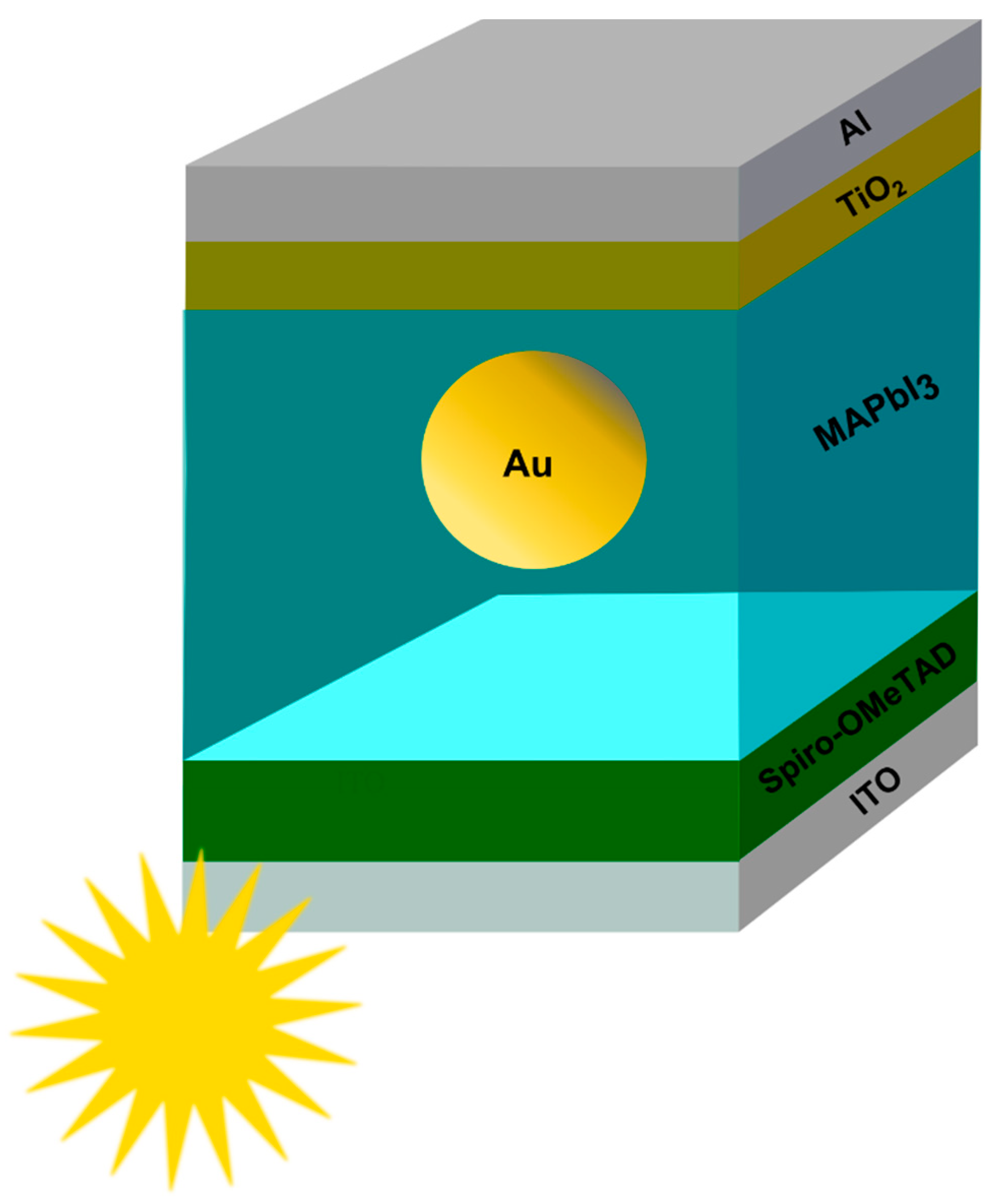
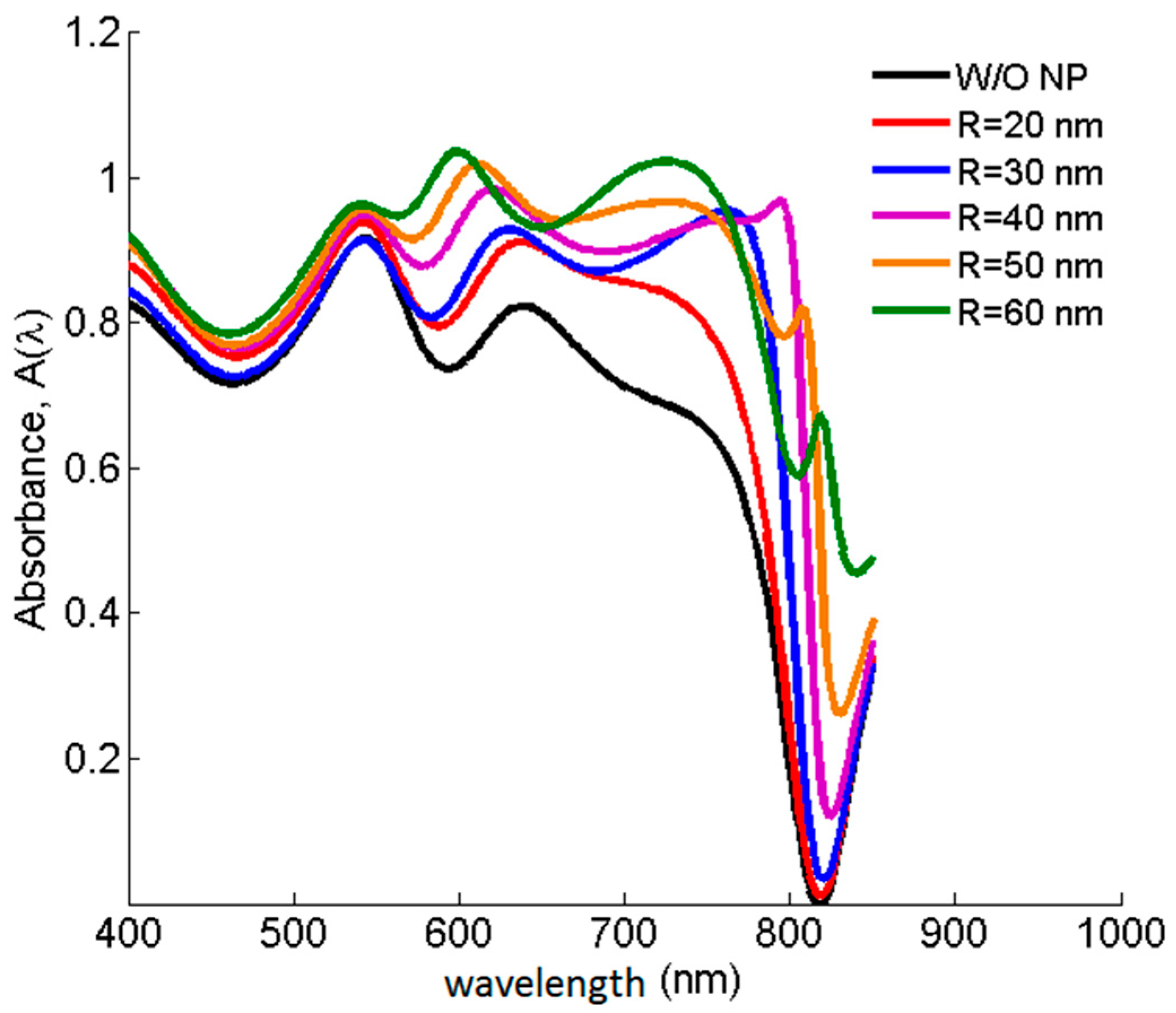
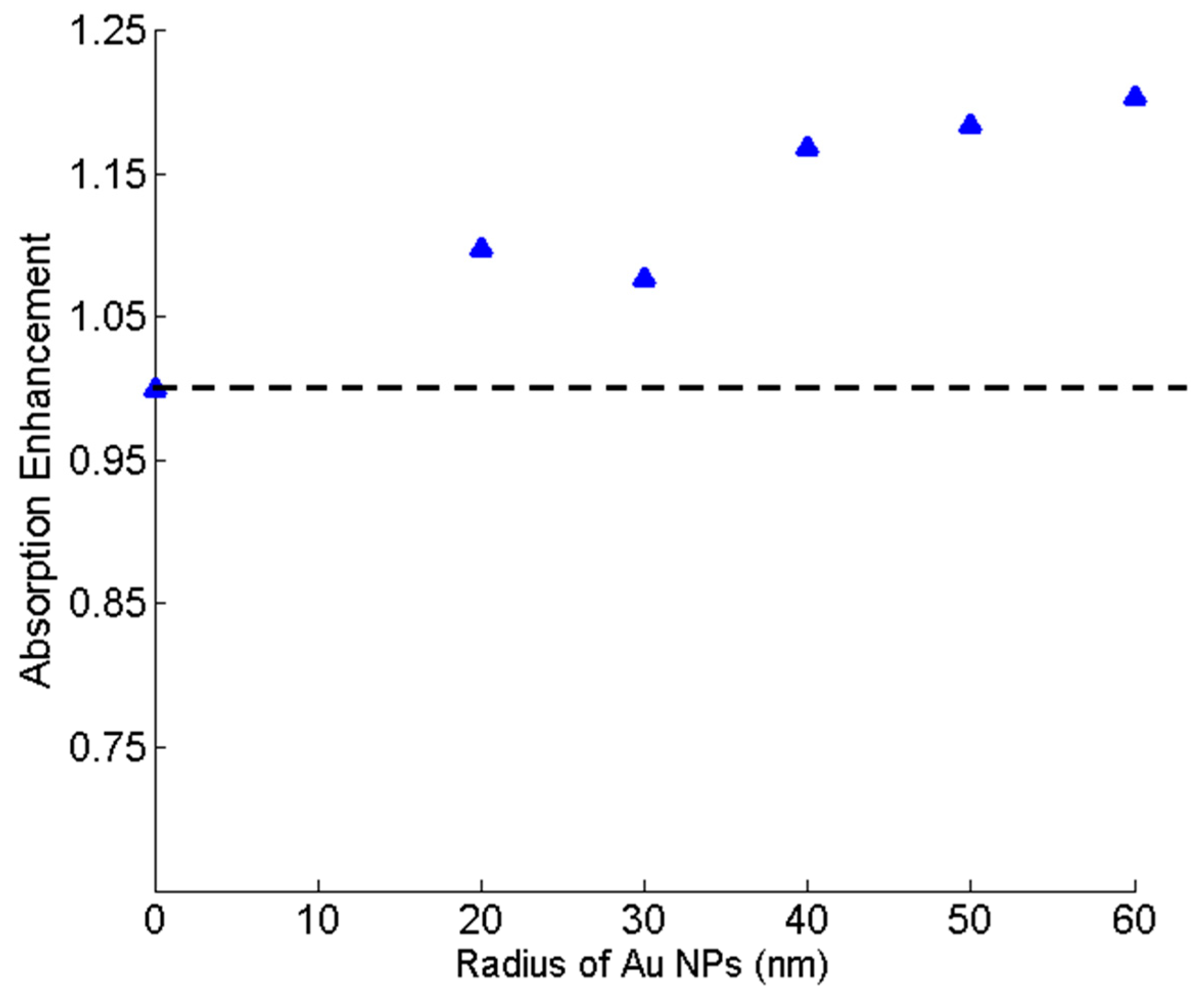
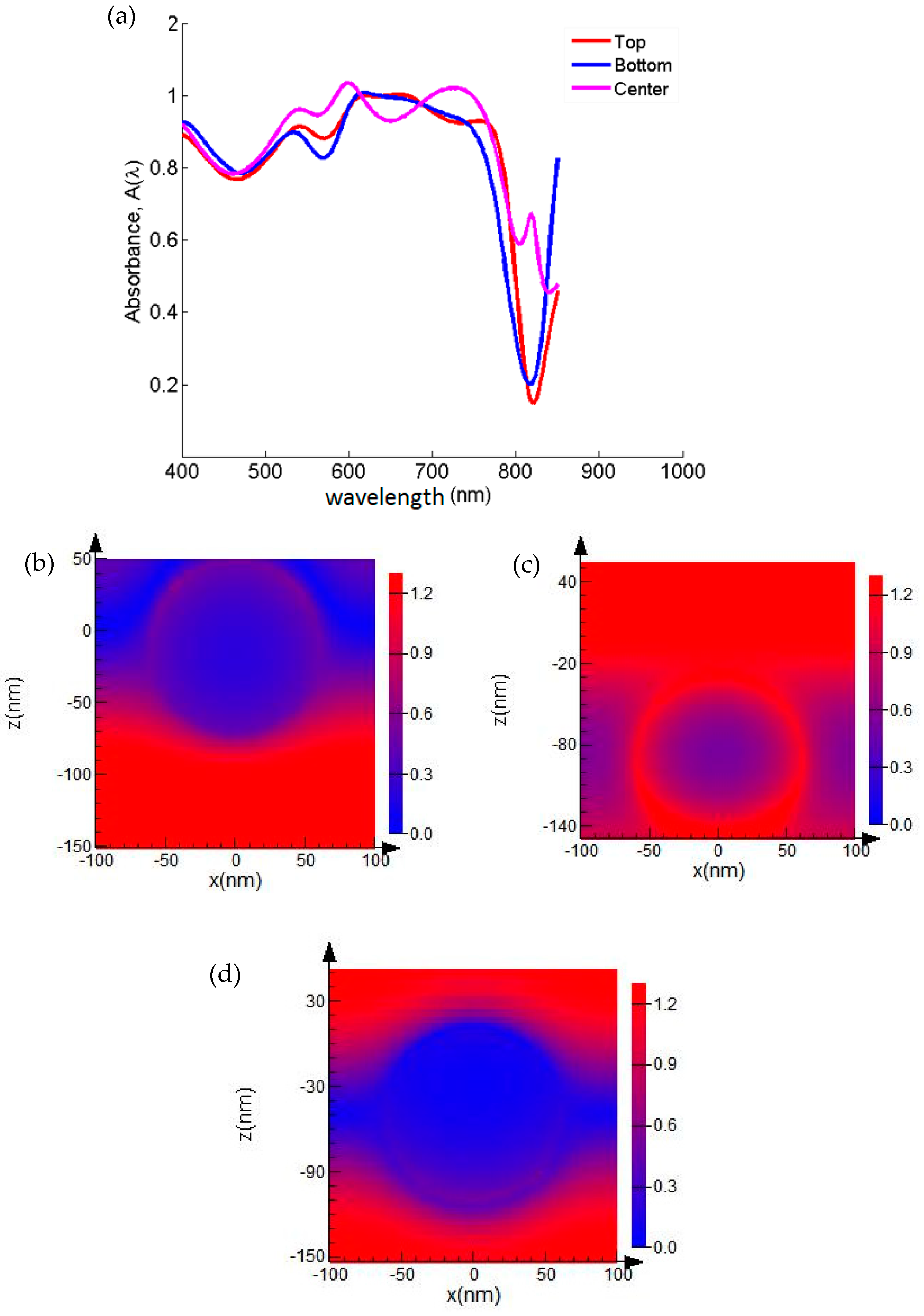
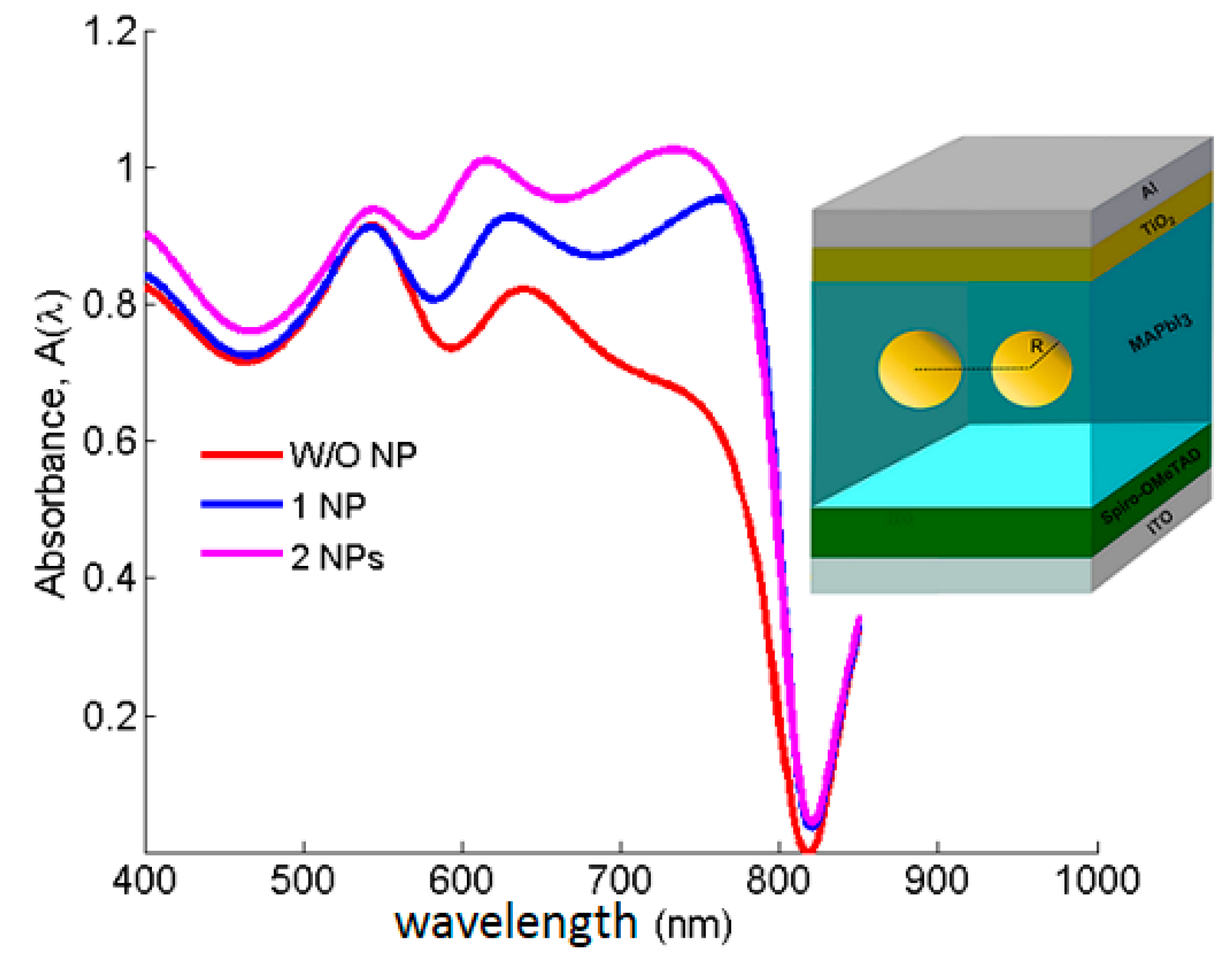
© 2019 by the authors. Licensee MDPI, Basel, Switzerland. This article is an open access article distributed under the terms and conditions of the Creative Commons Attribution (CC BY) license (http://creativecommons.org/licenses/by/4.0/).
Share and Cite
Ghahremanirad, E.; Olyaee, S.; Hedayati, M. The Influence of Embedded Plasmonic Nanostructures on the Optical Absorption of Perovskite Solar Cells. Photonics 2019, 6, 37. https://doi.org/10.3390/photonics6020037
Ghahremanirad E, Olyaee S, Hedayati M. The Influence of Embedded Plasmonic Nanostructures on the Optical Absorption of Perovskite Solar Cells. Photonics. 2019; 6(2):37. https://doi.org/10.3390/photonics6020037
Chicago/Turabian StyleGhahremanirad, Elnaz, Saeed Olyaee, and Maryam Hedayati. 2019. "The Influence of Embedded Plasmonic Nanostructures on the Optical Absorption of Perovskite Solar Cells" Photonics 6, no. 2: 37. https://doi.org/10.3390/photonics6020037




